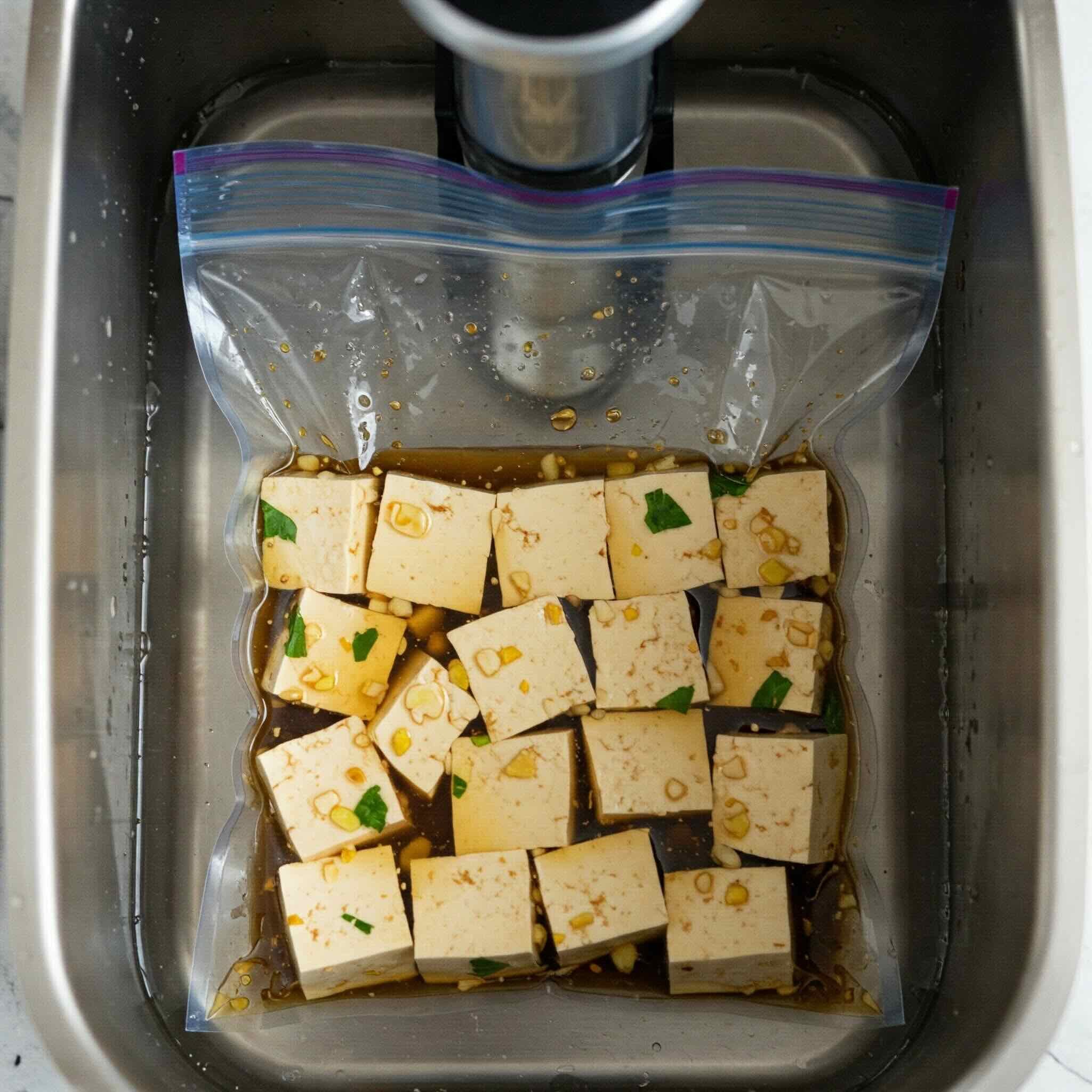Sous Vide Tofu Science – Is Low and Slow Cooking Worth It?
Sous vide cooking has long been a favourite among chefs for its precision, consistency, and control—but can this technique transform tofu into something extraordinary? Or is it just another culinary fad?
In this deep dive, we explore the science of sous vide tofu, compare it to traditional cooking methods, and reveal whether it’s worth the extra time and gear for plant-based cooks seeking texture and flavour perfection.
🔬 What Is Sous Vide Cooking?
Sous vide (French for “under vacuum”) is a method of cooking food in a vacuum-sealed bag at a precise, low temperature in a water bath—typically between 60–90°C (140–195°F).
✔ It’s gentle, even, and controlled.
✔ It prevents overcooking or moisture loss.
✔ It’s ideal for infusing marinades deeply into ingredients.
🔥 Pro Tip: You don’t need a fancy vacuum sealer. Zip-lock bags + water displacement work perfectly at home.
🧪 Why Tofu + Sous Vide Works (Scientifically)
Tofu is a protein-rich, porous matrix of soy curds held together by moisture. Sous vide cooking offers three unique benefits for this structure:
1️⃣ Texture Refinement
✔ Tofu won’t crumble or toughen—low heat stabilises protein bonds while keeping it supple.
✔ It gently firms the tofu without creating a rubbery crust.
2️⃣ Deep Marination
✔ Warm water enhances marinade diffusion, pushing flavour into tofu’s core over time.
✔ Unlike surface-only flavour from pan-searing, sous vide tofu is seasoned from the inside out.
3️⃣ Moisture Management
✔ Tofu retains its natural juiciness.
✔ No risk of burning, drying out, or uneven cooking.
🔥 Pro Tip: Tofu is like a sponge—sous vide keeps it hydrated while saturating it with flavour.
🛠️ How to Sous Vide Tofu at Home (Step-by-Step)
What You’ll Need:
Extra-firm tofu, pressed
Zip-lock bag or vacuum sealer bag
Sous vide immersion circulator (Anova, Joule, etc.) or DIY stovetop method
Pot or container large enough for a water bath
Marinade of choice (soy sauce, miso, maple, spices)
Method:
1️⃣ Press tofu for 15–30 mins to remove excess moisture.
2️⃣ Slice into slabs or cubes for better marinade contact.
3️⃣ Add tofu + marinade to the bag and remove as much air as possible.
4️⃣ Set sous vide to 85°C (185°F) and submerge tofu.
5️⃣ Cook for 1 to 3 hours.
✔ 1 hour = subtle flavour and soft texture
✔ 2–3 hours = deep infusion, firmer bite, richer mouthfeel
🔥 Pro Tip: For best results, sear or grill tofu briefly after sous vide to add a crispy finish.
🍽️ Comparing Results – Sous Vide vs Traditional Methods
🔥 Verdict: Sous vide offers unmatched control and flavour infusion—but shines most when combined with finishing techniques like searing or glazing.
🔄 Best Uses for Sous Vide Tofu
✔ Grain bowls – Juicy, infused cubes add depth and protein.
✔ Noodle dishes – Silky texture pairs beautifully with broths and sauces.
✔ BBQ skewers – Pre-sous vide, then grill for layered flavour.
✔ Meal prep – Store cooked tofu in its bag; just reheat and finish when ready.
🔥 Pro Tip: Sous vide tofu stays fresh longer—up to 7 days refrigerated in its sealed marinade.
❌ Common Mistakes (And How to Avoid Them)
🚫 Skipping pressing? → Too much water = diluted marinade.
🚫 Too low temp? → Under-infused or mushy tofu. Stick to 80–85°C.
🚫 Overcrowding the bag? → Prevents even cooking. Leave space between cubes.
🚫 No finishing step? → Add crispness with a sear or glaze for texture contrast.
🔥 Pro Tip: Use aromatics like ginger, garlic, or lemongrass in the bag to build complexity.
🌟 Final Takeaway: Is It Worth It?
✔ If you love precision, consistency, and deep flavour—yes.
✔ It’s perfect for elevated plant-based cooking and pro-level meal prep.
✔ Sous vide is not a replacement, but a powerful complement to traditional methods.
🔥 Your Turn: Have you tried sous vide tofu—or want to? What questions do you have about this low & slow technique? Drop them below! 🛁🥢


